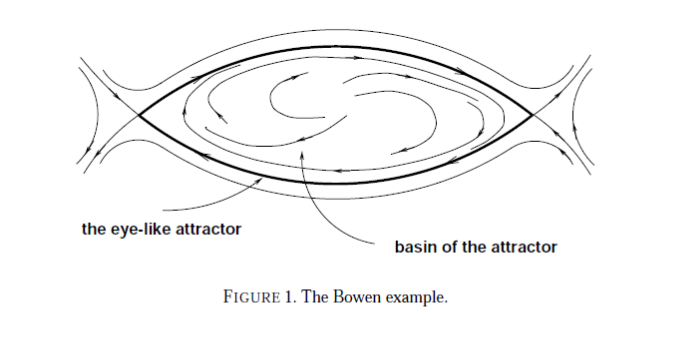Notations:
- $\mathcal{R}(f)$ denotes the chain recurrent set of $f$
- $NW(f)$ denotes the non wandering set of $f$
- $R(f)$ denotes the recurrent set of $f$ ($x: x\in \omega(x)$)
Given compact metric space X and homeomorphism $f: X \rightarrow X$, $g: X \rightarrow \mathbb{R}$ is a complete Lyapunov function for $f$ if:
$\forall \ p \notin \mathcal{R}(f)$, $\ g(f(p)) < g(p)$
$\forall \ p, q \in \mathcal{R}(f)$, $\ g(p) = g(q)$ iff $ p \sim q$
$g(\mathcal{R}(f))$ is compact and nowhere dense in $ \mathbb{R}$
Conley's Theorem (or fundamental theorem of dynamical systems):
Complete Lyapunov function exists for any homeomorphisms on compact metric spaces.
My Question: I'd like to understand why this theorem is called fundemental theorem of dynamical systems, It seems to me it says that the whole interesting dynamic $ f $ is contained in the chain recurrent set of $f.$ this was what I was told, but it is not very clear to me.
An example to explain my question: In the case of all non-wandering of $ f $ we prove that given any neighborhood $U$ of $NW(f)$ there is a uniform time $T$ for which $$ \text{Card} \{ k: f^k(x)\notin U \} \leq T $$
In this sense it seems clear that the non wandering set contains much of the interesting dynamics of $ f $.
However in the case of the chain recurrent set is not clear to me nothing that occurs in the previous example.
So like an explanation of why the whole interesting dynamic $ f $ is concentrated in the chain recurrent, and wanted to better understand why the theorem of Conley is called "fundamental".
Another question: Would an example of a dynamic system where $NW(f)\setminus \overline{R(f)}$ is not empty, or at least the idea of what kind of dynamic phenomenon can produce these point.

